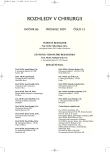Hemipelvectomy, Constant Surgical Dilema
Authors:
I. Gavrankapetanovic 1; F. Gavrankapetanovic 1; S. Becirbegovic 1; H. Tanovic 1; P. Višňa 2; E. Jaganjac 2; T. Kuba 2
Authors‘ workplace:
University Clinical Center Sarajevo, Clinic for orthopedics and traumatology, Sarajevo Bosnia and Herzegovina, head: prof. MUDr. I. Gavrankapetanovic
1; Traumatologické oddělení, I. ortopedická klinika 1. LF UK a FN Motol, přednosta: prof. MUDr. A. Sosna, DrSc.
2
Published in:
Rozhl. Chir., 2007, roč. 86, č. 12, s. 661-665.
Category:
Monothematic special - Original
Overview
Introduction:
In this report we present our experience in „post war” environment in our institution. Any king of pelvic surgery is challenging and impacts significantly on limb and visceral function. Any surgeon has to ask a question „is heroic surgery justifiable“. We aim to asses functional, oncologic and surgical outcomes following pelvis tumor resections.
Materials and methods:
Between 1998–2005, 7 patients (mean age 48.2 years) underwent pelvic tumor resections. All of them were primary malignant tumors. We did not identify secondary tumors and benign tumors in our series. Bone tumors were 3 osteosarcomas and 4 chondrosarcomas. Tumors involved the ilium, acetabulum, pubic bones, sacrum or a combination of these. No patient had metastases at presentation.
Results:
All 7 patients underwent hindquarter amputations. Surgical margins were marginal (4), wide (2), and radical (1). There was 1 intraoperative death, 2 local recurrences and 2 metastases. Death from disease occurred at a mean of 12.4 months with mean follow-up of 24 (1–72) months. Emotional acceptance was surprisingly high. Pelvic resections are complex. Functional outcome is significantly affected by surgery. Disease control is similar to limb tumors. Emotional acceptance of surgery in survivors was surprisingly high.
Conclusion:
Major pelvic resection for malignancy appears justified.
Key words:
Osteosarcoma – chondrosarcoma – pelvis – hemipelvectomy
Sources
1. Enneking, W. F., Dunham, W., Gebhardt, M. C., Malawar, M., Pritchard, D. J. A system for the functional evaluation of reconstructive procedures after surgical treatment of tumors of the musculoskeletal system. Clin. Orthop., 1993; 286: 241–246.
2. Hillmann, A., Hoffmann, C., Gosheger, G., Rodl, R., Winkelmann, W., Ozaki, T. Tumours of the pelvis: complications after reconstruction. Arch. Orthop. Trauma Surg,, 2003; 123(7): 340–344.
3. Pring, M. E., Weber, K. L., Unni, K. K., Sim, F. H. Chondrosarcoma of the pelvis. A review of sixty – four cases. J. Bone Point. Surg., 2001; 83-A(11):1630–1642.
4. Ozaki, T., Hillmann, A., Bettin, D., Wuisman, P., Winkelmann, W. High complication rates with pelvic allograft. Experience of 22 sarcoma resections. Acta Orthop. Scand., 1996; 67(4): 333–338.
5. Bacci, G., Ruggieri, P., Bertoni, F., Ferrari, S., Longhi, A., Biagini, R., Zavatta, M., Versari, M., Forni, C. Local and systemic control for osteosarcoma of the extremity treated with neoadjuvant chemotherapy and limb salvage surgery: the Rizzoli experience. Oncol. Rep., 2000; 7(5): 1129–1133.
6. Sluga, M., Windhager, R., Lang, S., Heknul, H., Bielack, S., Kotz, R. Local and systemic control after ablative and limb sparing surgery in patients with osteosarcoma. Clin. Orthop., 1999; (358): 120–127.
7. Wirbel, R. J., Schulte, M., Mutschler, W. E. Surgical treatment of pelvic sarcomas: oncologic and functional outcome. Clin. Orthop., 2001; 390: 190–205.
Labels
Surgery Orthopaedics Trauma surgeryArticle was published in
Perspectives in Surgery

2007 Issue 12
- Metamizole vs. Tramadol in Postoperative Analgesia
- Metamizole at a Glance and in Practice – Effective Non-Opioid Analgesic for All Ages
- Possibilities of Using Metamizole in the Treatment of Acute Primary Headaches
Most read in this issue
- Stapled Hemorrhoidopexy (Long method) – Procedure for Prolapsing Hemorrhoids (PPH) – Eight-Year Experience with the Method
- The Commonest Neuroendocrine GIT Tumors – Carcinoids
- Malignant Somatostatinoma (Brief Overview and a Case Review)
- Current Treatment Options of Osteoporotic Thoracolumbal Spinal Fractures
